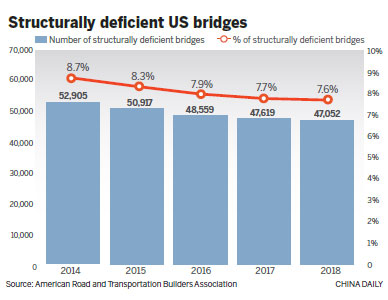US bridges in dire need of repair, report says
Crumbling bridges in the United States are in urgent need of repair but it could take eight decades to fix them, according to a major industry report and specialists.
An analysis by the American Road and Transportation Builders Association of the recently released US Department of Transportation 2018 National Bridge Inventory database showed that 47,052 bridges- nearly 8 percent of the nation's 616,087 bridges - are "structurally deficient", which means the bridges need repairs but are not unsafe for public travel. Of that total number, 1,800 are interstate bridges crossed 60 million times daily, according to the report.
The number of structurally deficient bridges is actually down from last year's report, according to the association.
The Washington-based ARTBA is a non-partisan organization which advocates for investment in transportation infrastructure, analyzes data from the Federal Highway Administration and releases an annual Deficient Bridge report.
Bridges are regularly inspected for safety on a scale of 0 to 9. Structurally deficient means that one of four key elements of the bridge is rated 4, which is poor, or below.
Previously, bridges could also be classified as structurally deficient if their overall structural evaluation was rated 4 or lower, or if they had insufficient waterway openings.
"The new definition does make a difference," ARTBA chief economist Alison Black said. "About 6,500 bridges that would've been structurally deficient are not under this (new) definition."
The structurally deficient bridges provide 174 million crossings for travelers a day and if placed end-to-end, they would stretch about 1,960 km, or nearly the distance between Miami and New York City, ARTBA said.
The five US states with the largest number of structurally deficient bridges are: Iowa (5,067), Pennsylvania (4,173), Oklahoma (3,234), Missouri (3,086) and Illinois (2,303), according to the ARTBA report.
Notable structurally deficient bridges in 2018, according to the report, include New York's Brooklyn Bridge, the Memorial Bridge at the Lincoln Memorial in Washington connecting with Arlington, Virginia, and the San Mateo-Hayward bridge crossing San Francisco Bay and stretching more than 11 km, the longest bridge in California.
It will take eight decades to repair bridges "at present funding levels", Andy Herman, former president of the American Society of Civil Engineers, told China Daily. "The average age of our bridges across the country is about 43 years old. When those bridges were designed, they probably had a 50-year design life."
Fortunately, he said, the bridges are required by federal laws to be inspected at least biannually and "if they find something really bad, they can close the bridge ... do some emergency repairs or reduce the load limit on a bridge... to keep the traveling public safe".
"Most of the bridges in the country are not owned by the federal government, they're owned by states or counties and even private owners," Herman said. "So those owners are the ones responsible for keeping the bridges in good repair and inspecting them, but the state departments of transportation get funding from the federal government, so getting those funds from Congress has a lot to do with how fast they can repair them."
A spokeswoman for the Federal Highway Administration, an agency within the US Department of Transportation, said: "Bridge conditions in the US have steadily improved over the years due to increased investment by bridge owners."
"All states have a maintenance and preservation plan in place to ensure necessary repairs are addressed. Under the national bridge inspection program, necessary repairs or correction action must be taken, when needed, for the bridge to remain open," said the spokeswoman.
The ASCE estimates that $4.6 trillion is needed to repair US infrastructure, including 6.44 million km of damaged roads and decaying bridges.
Last month, US President Donald Trump unveiled his$4.7 trillion 2020 budget proposal and included a request for$1.5 trillion toward infrastructure by spending$200 billion in federal investment over a decade.
In Congress, everyone agrees infrastructure needs fixing, but there is little agreement on how to pay for it.
From 2013 to 2018, at least 28 states raised their own gas tax. But raising the federal tax to fix infrastructure brings with it facing voters in the 2020 election for Congress and the White House.
belindarobinson@chinadailyusa.com

(China Daily 04/16/2019 page3)


















